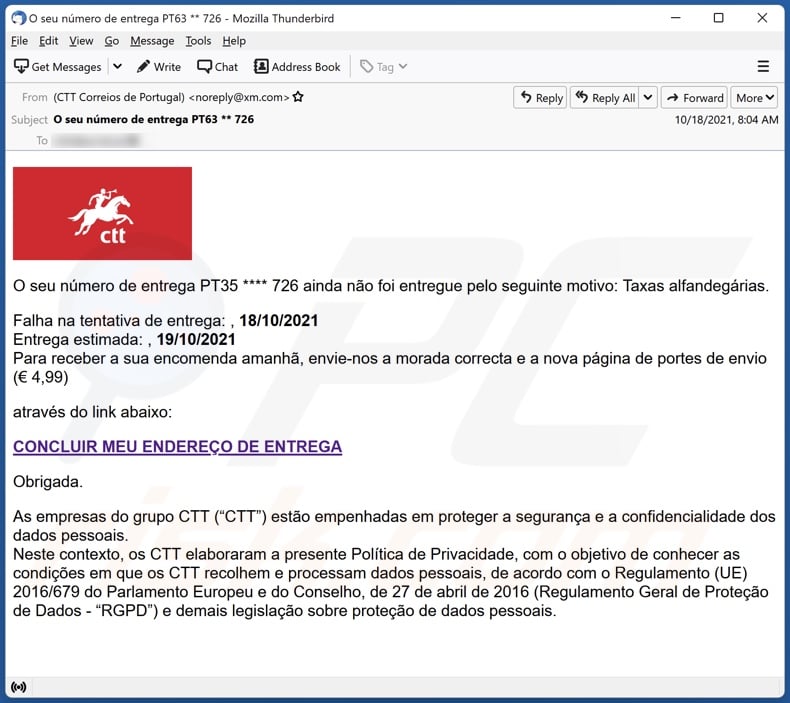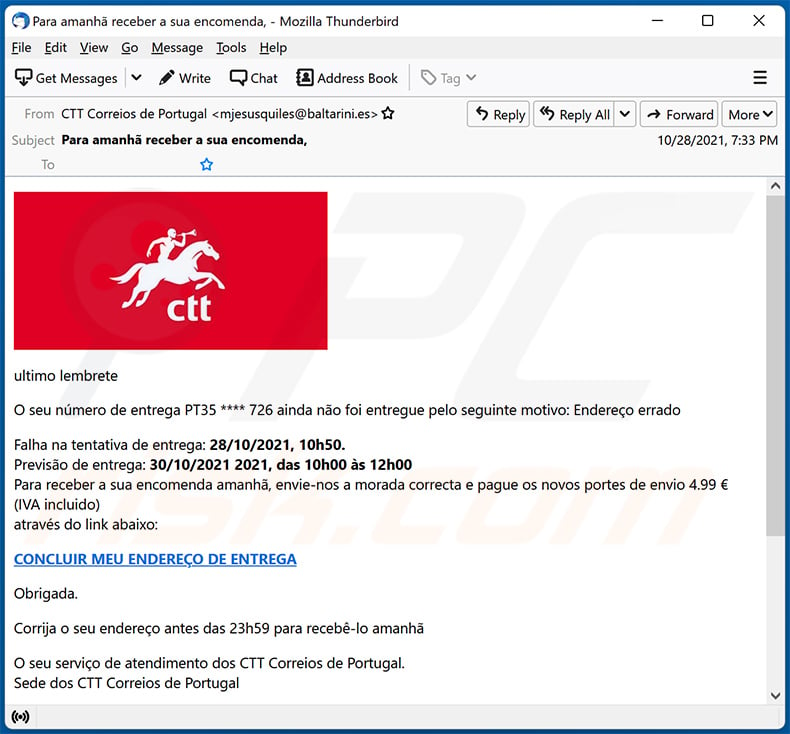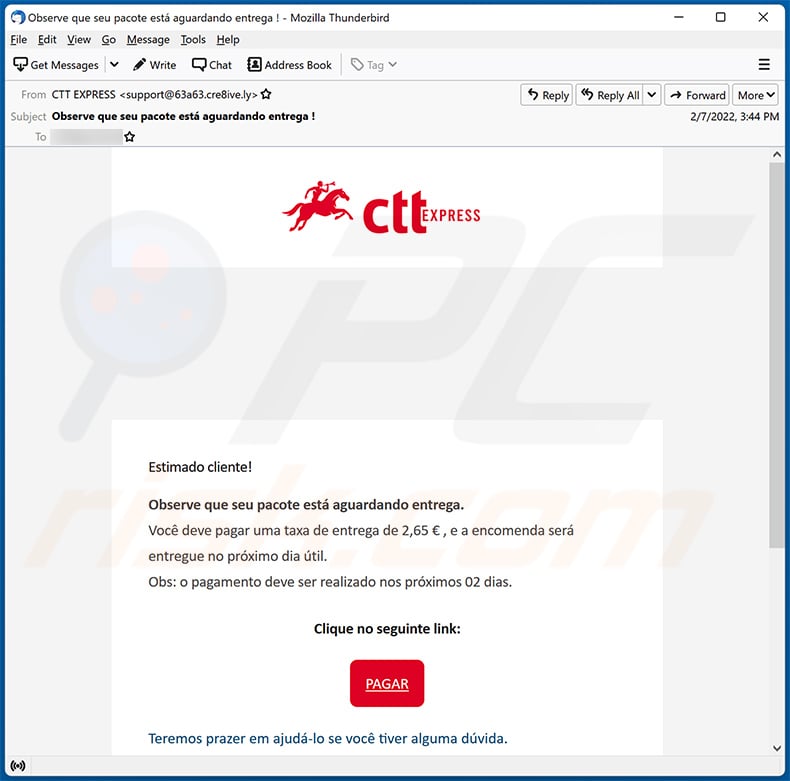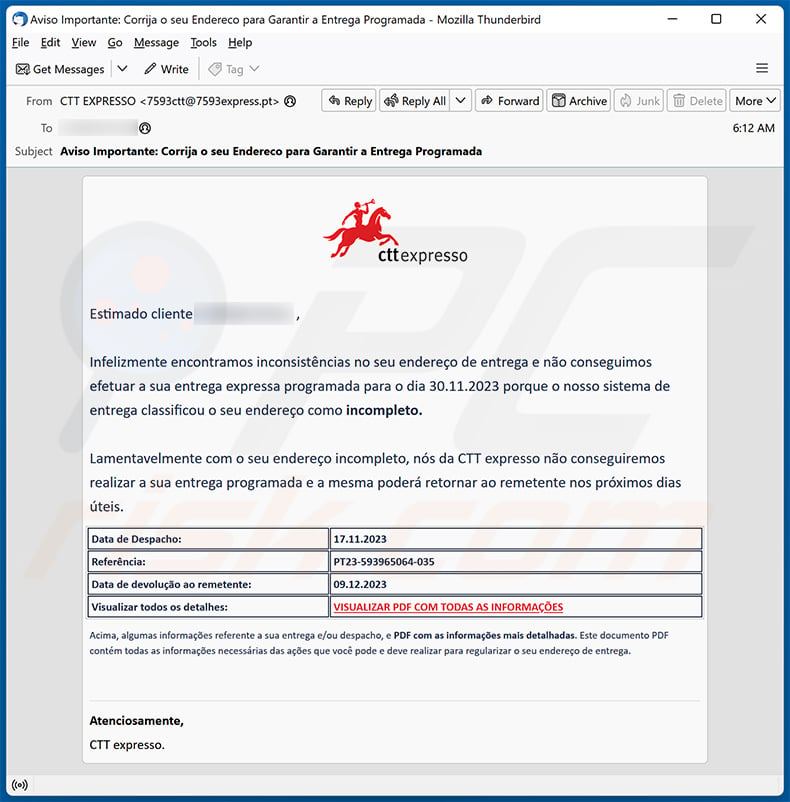Get free scan and check if your device is infected.
Remove it nowTo use full-featured product, you have to purchase a license for Combo Cleaner. Seven days free trial available. Combo Cleaner is owned and operated by RCS LT, the parent company of PCRisk.com.
What is "CTT" email scam?
"CTT email scam" refers to a spam campaign. The emails sent through it are disguised as failed delivery notifications from CTT - Correios de Portugal, S.A. – the Portuguese national postal service and commercial group dealing in banking and e-commerce.
It must be emphasized that these letters are fake and in no way associated with the real CTT. This spam mail aims to promote a phishing website designed to record vulnerable data entered into it.

"CTT" email scam in detail
According to a rough translation, the "CTT" scam emails state that a delivery has failed due to unpaid customs fees. The letters contain brief particulars concerning the unsuccessful delivery and a more detailed statement concerning data confidentiality.
Phishing scams can target a wide variety of data. Sites of this type can be disguised as legitimate webpages (e.g., sign-in pages of online accounts).
Typically such scams target personally identifiable information, account usernames/passwords, finance-related data (e.g., banking account details, credit card numbers, etc.), and similar. The goal of all scams is to generate revenue, yet how they achieve it - depends on the cyber criminals' modus operandi.
Email accounts are commonly targeted as they are often used to register other accounts, platforms, and services. Hence, through stolen emails - access/control may be gained over content connected to them.
Communication (e.g., email, social networking, etc.) platforms can be used to promote scams and malware. Alternatively, scammers can pretend to be the account's genuine owner and ask their contacts for loans. Finance-related accounts (e.g., online banking, money transferring, e-commerce, etc.) can be used to make fraudulent transactions and/or online purchases.
Scam emails like "CTT" may also request recipients to make bogus payments (e.g., fake customs fees). In addition to direct monetary loss, users may also inadvertently expose their financial data - that the criminals can use for unauthorized transactions and purchases.
In summary, by trusting the "CTT" scam emails, users can experience severe privacy issues, financial losses, and identity theft.
| Name | CTT Email Scam |
| Threat Type | Phishing, Scam, Social Engineering, Fraud |
| Fake Claim | Emails claim that a delivery has failed due to unpaid customs fees. |
| Disguise | Emails are disguised as notifications from CTT - Correios de Portugal, S.A. |
| Symptoms | Unauthorized online purchases, changed online account passwords, identity theft, illegal access of the computer. |
| Distribution methods | Deceptive emails, rogue online pop-up ads, search engine poisoning techniques, misspelled domains. |
| Damage | Loss of sensitive private information, monetary loss, identity theft. |
| Malware Removal (Windows) |
To eliminate possible malware infections, scan your computer with legitimate antivirus software. Our security researchers recommend using Combo Cleaner. Download Combo CleanerTo use full-featured product, you have to purchase a license for Combo Cleaner. 7 days free trial available. Combo Cleaner is owned and operated by RCS LT, the parent company of PCRisk.com. |
Spam campaigns in general
"YOUR CORPORATE NETWORK HAS BEEN HACKED", "Host Europe Email Scam", "Network Solutions Email Scam", and "Covid-19 Stimulus Payment" are a few examples of scam emails.
Spam campaigns are used for phishing and various other schemes. Furthermore, these emails can also be employed to proliferate malware (e.g., ransomware, trojans, cryptocurrency miners, etc.). Due to how widespread spam mail is, exercising caution with incoming emails and messages is strongly recommended.
How do spam campaigns infect computers?
Spam emails can have infectious files as attachments or download links. These files can be Microsoft Office and PDF documents, archives, executables, JavaScript, etc. When virulent files are opened - malware download/installation is jumpstarted.
For example, Microsoft Office documents infect systems by executing malicious macro commands. This process is triggered when a document is opened in Microsoft Office versions released before 2010. Newer versions have "Protected View" mode that prevents this from triggering; instead, users can manually enable macros. It is noteworthy that infectious documents often contain deceptive messages to trick users into allowing macro commands.
How to avoid installation of malware?
The attachments and links found in suspicious or irrelevant emails - must not be opened. It is recommended to use Microsoft Office versions released after 2010.
In addition to spam mail, malware is spread via dubious download channels (e.g., unofficial and freeware sites, Peer-to-Peer sharing networks, etc.), illegal software activation tools ("cracks"), and fraudulent updates. Hence, it is advised to always download from official/verified sources and activate/update programs with tools provided by genuine developers.
It is crucial to have a reputable anti-virus installed and kept updated. This software has to be used to run regular system scans and to remove threats. If you've already opened malicious attachments, we recommend running a scan with Combo Cleaner Antivirus for Windows to automatically eliminate infiltrated malware.
Text presented in the fake "CTT" email letter:
Subject: O seu número de entrega PT63 ** 726
O seu número de entrega PT35 **** 726 ainda não foi entregue pelo seguinte motivo: Taxas alfandegárias.
Falha na tentativa de entrega: , 18/10/2021
Entrega estimada: , 19/10/2021
Para receber a sua encomenda amanhã, envie-nos a morada correcta e a nova página de portes de envio (€ 4,99)
através do link abaixo:
CONCLUIR MEU ENDEREÇO DE ENTREGA
Obrigada.
As empresas do grupo CTT (“CTT”) estão empenhadas em proteger a segurança e a confidencialidade dos dados pessoais.
Neste contexto, os CTT elaboraram a presente Política de Privacidade, com o objetivo de conhecer as condições em que os CTT recolhem e processam dados pessoais, de acordo com o Regulamento (UE)
2016/679 do Parlamento Europeu e do Conselho, de 27 de abril de 2016 (Regulamento Geral de Proteção de Dados - “RGPD”) e demais legislação sobre proteção de dados pessoais.
Another example of CTT scam email:

Text presented within:
Subject: Para amanhã receber a sua encomenda,
ultimo lembrete
O seu número de entrega PT35 **** 726 ainda não foi entregue pelo seguinte motivo: Endereço errado
Falha na tentativa de entrega: 28/10/2021, 10h50.
Previsão de entrega: 30/10/2021 2021, das 10h00 às 12h00
Para receber a sua encomenda amanhã, envie-nos a morada correcta e pague os novos portes de envio 4.99 €
(IVA incluido)
através do link abaixo:CONCLUIR MEU ENDEREÇO DE ENTREGA
Obrigada.
Corrija o seu endereço antes das 23h59 para recebê-lo amanhã
O seu serviço de atendimento dos CTT Correios de Portugal.
Sede dos CTT Correios de PortugalPreços dos serviços postais aplicáveis ao serviço nacional e internacional. Os CTT disponibilizam dois níveis de preços: P
reços Base e Preços de Quantidade.Preços Base:
Aplicáveis a expedições efetuadas por qualquer pessoa singular ou coletiva através de envios selados,
franquiados ao balcão e pré-pagos ou no âmbito de um contrato formalizado com os CTT
excetuando máquinas de franquiar), cujo volume de faturação, no ano civil anterior,
não atingiu o valor mínimo definido para o respetivo tipo de contrato.
Preços de Quantidade: Aplicáveis a expedições efetuadas por pessoa singular ou coletiva, no âmbito de um contrato formalizado com os CTT,
cujo volume de faturação, no ano civil anterior, atingiu o valor mínimo definido para o respetivo tipo de contrato.
Another example of CTT-themed spam email promoting a phishing site:

Text presented within:
Subject: Observe que seu pacote está aguardando entrega !
Estimado cliente!
Observe que seu pacote está aguardando entrega.
Você deve pagar uma taxa de entrega de 2,65 € , e a encomenda será entregue no próximo dia útil.
Obs: o pagamento deve ser realizado nos próximos 02 dias.
Clique no seguinte link:
PAGAR
Teremos prazer em ajudá-lo se você tiver alguma dúvida.Com os melhores votos
CTT
© Copyright 2022 CTT
Av. portugal, 133 - lisbon Brasilândia, MT, 78860-000, portugal
Contact us.
support@ctt.biz.pt
Screenshot of yet another email from "CTT" spam campaign:

Text presented within:
Subject: Aviso Importante: Corrija o seu Endereco para Garantir a Entrega Programada
Estimado cliente - ,Infelizmente encontramos inconsistências no seu endereço de entrega e não conseguimos efetuar a sua entrega expressa programada para o dia 30.11.2023 porque o nosso sistema de entrega classificou o seu endereço como incompleto.
Lamentavelmente com o seu endereço incompleto, nós da CTT expresso não conseguiremos realizar a sua entrega programada e a mesma poderá retornar ao remetente nos próximos dias úteis.
Data de Despacho: 17.11.2023
Referência: PT23-593965064-035
Data de devolução ao remetente: 09.12.2023
Visualizar todos os detalhes: VISUALIZAR PDF COM TODAS AS INFORMAÇÕES
Acima, algumas informações referente a sua entrega e/ou despacho, e PDF com as informações mais detalhadas. Este documento PDF contém todas as informações necessárias das ações que você pode e deve realizar para regularizar o seu endereço de entrega.Atenciosamente,
CTT expresso.
Instant automatic malware removal:
Manual threat removal might be a lengthy and complicated process that requires advanced IT skills. Combo Cleaner is a professional automatic malware removal tool that is recommended to get rid of malware. Download it by clicking the button below:
DOWNLOAD Combo CleanerBy downloading any software listed on this website you agree to our Privacy Policy and Terms of Use. To use full-featured product, you have to purchase a license for Combo Cleaner. 7 days free trial available. Combo Cleaner is owned and operated by RCS LT, the parent company of PCRisk.com.
Quick menu:
- What is CTT spam?
- Types of malicious emails.
- How to spot a malicious email?
- What to do if you fell for an email scam?
Types of malicious emails:
![]() Phishing Emails
Phishing Emails
Most commonly, cybercriminals use deceptive emails to trick Internet users into giving away their sensitive private information, for example, login information for various online services, email accounts, or online banking information.
Such attacks are called phishing. In a phishing attack, cybercriminals usually send an email message with some popular service logo (for example, Microsoft, DHL, Amazon, Netflix), create urgency (wrong shipping address, expired password, etc.), and place a link which they hope their potential victims will click on.
After clicking the link presented in such email message, victims are redirected to a fake website that looks identical or extremely similar to the original one. Victims are then asked to enter their password, credit card details, or some other information that gets stolen by cybercriminals.
![]() Emails with Malicious Attachments
Emails with Malicious Attachments
Another popular attack vector is email spam with malicious attachments that infect users' computers with malware. Malicious attachments usually carry trojans that are capable of stealing passwords, banking information, and other sensitive information.
In such attacks, cybercriminals' main goal is to trick their potential victims into opening an infected email attachment. To achieve this goal, email messages usually talk about recently received invoices, faxes, or voice messages.
If a potential victim falls for the lure and opens the attachment, their computers get infected, and cybercriminals can collect a lot of sensitive information.
While it's a more complicated method to steal personal information (spam filters and antivirus programs usually detect such attempts), if successful, cybercriminals can get a much wider array of data and can collect information for a long period of time.
![]() Sextortion Emails
Sextortion Emails
This is a type of phishing. In this case, users receive an email claiming that a cybercriminal could access the webcam of the potential victim and has a video recording of one's masturbation.
To get rid of the video, victims are asked to pay a ransom (usually using Bitcoin or another cryptocurrency). Nevertheless, all of these claims are false - users who receive such emails should ignore and delete them.
How to spot a malicious email?
While cyber criminals try to make their lure emails look trustworthy, here are some things that you should look for when trying to spot a phishing email:
- Check the sender's ("from") email address: Hover your mouse over the "from" address and check if it's legitimate. For example, if you received an email from Microsoft, be sure to check if the email address is @microsoft.com and not something suspicious like @m1crosoft.com, @microsfot.com, @account-security-noreply.com, etc.
- Check for generic greetings: If the greeting in the email is "Dear user", "Dear @youremail.com", "Dear valued customer", this should raise suspiciousness. Most commonly, companies call you by your name. Lack of this information could signal a phishing attempt.
- Check the links in the email: Hover your mouse over the link presented in the email, if the link that appears seems suspicious, don't click it. For example, if you received an email from Microsoft and the link in the email shows that it will go to firebasestorage.googleapis.com/v0... you shouldn't trust it. It's best not to click any links in the emails but to visit the company website that sent you the email in the first place.
- Don't blindly trust email attachments: Most commonly, legitimate companies will ask you to log in to their website and to view any documents there; if you received an email with an attachment, it's a good idea to scan it with an antivirus application. Infected email attachments are a common attack vector used by cybercriminals.
To minimise the risk of opening phishing and malicious emails we recommend using Combo Cleaner Antivirus for Windows.
Example of a spam email:

What to do if you fell for an email scam?
- If you clicked on a link in a phishing email and entered your password - be sure to change your password as soon as possible. Usually, cybercriminals collect stolen credentials and then sell them to other groups that use them for malicious purposes. If you change your password in a timely manner, there's a chance that criminals won't have enough time to do any damage.
- If you entered your credit card information - contact your bank as soon as possible and explain the situation. There's a good chance that you will need to cancel your compromised credit card and get a new one.
- If you see any signs of identity theft - you should immediately contact the Federal Trade Commission. This institution will collect information about your situation and create a personal recovery plan.
- If you opened a malicious attachment - your computer is probably infected, you should scan it with a reputable antivirus application. For this purpose, we recommend using Combo Cleaner Antivirus for Windows.
- Help other Internet users - report phishing emails to Anti-Phishing Working Group, FBI’s Internet Crime Complaint Center, National Fraud Information Center and U.S. Department of Justice.
Frequently Asked Questions (FAQ)
Why did I receive this email?
Spam emails are not personal; they are sent by the thousand in large-scale operations. The cyber criminals' hope - is that at least some recipients will fall for their schemes.
I have provided my personal information when tricked by this spam email, what should I do?
If you've disclosed account credentials - immediately change the passwords of all potentially exposed accounts and contact their official support. And if you've provided other personal data (e.g., ID card details, credit card numbers, etc.) - contact the relevant authorities without delay.
I have read a spam email but didn't open the attachment, is my computer infected?
No, opening and reading a spam email is harmless. Infection processes are triggered by opening attached files or the links present in such emails.
I have downloaded and opened a file attached to a spam email, is my computer infected?
Whether your system was infected - depends on the attachment's format. If it was an executable - then yes, your system is most likely infected. However, if it was a document (e.g., .doc, .pdf, etc.) - you might have avoided jumpstarting an infection, as these formats often require additional actions (e.g., macro command enablement, etc.).
Will Combo Cleaner remove malware infections present in email attachments?
Yes, Combo Cleaner can scan systems, detect and eliminate most known malware infections. It is noteworthy that performing a full system scan is crucial, as high-end malicious programs usually hide deep within the system.
Share:

Tomas Meskauskas
Expert security researcher, professional malware analyst
I am passionate about computer security and technology. I have an experience of over 10 years working in various companies related to computer technical issue solving and Internet security. I have been working as an author and editor for pcrisk.com since 2010. Follow me on Twitter and LinkedIn to stay informed about the latest online security threats.
PCrisk security portal is brought by a company RCS LT.
Joined forces of security researchers help educate computer users about the latest online security threats. More information about the company RCS LT.
Our malware removal guides are free. However, if you want to support us you can send us a donation.
DonatePCrisk security portal is brought by a company RCS LT.
Joined forces of security researchers help educate computer users about the latest online security threats. More information about the company RCS LT.
Our malware removal guides are free. However, if you want to support us you can send us a donation.
Donate
▼ Show Discussion